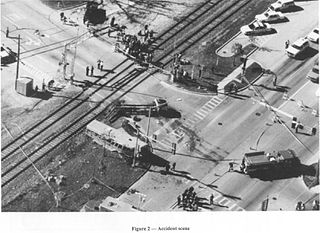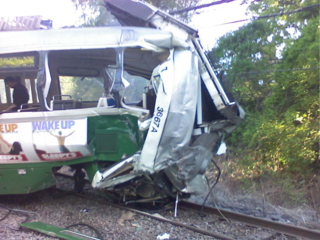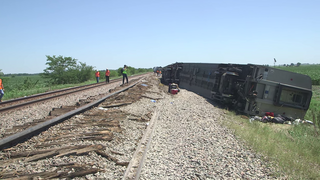Related Research Articles

On March 15, 1999, Amtrak's southbound City of New Orleans passenger train collided with a semi-trailer truck in the village of Bourbonnais, Illinois, United States. Most of the train derailed, killing eleven people. A National Transportation Safety Board (NTSB) investigation into the accident attributed the cause to the truck driver trying to beat the train across a grade crossing. The NTSB's recommendations from the accident included increased enforcement of grade crossing signals, the installation of train event recorders at all new or improved grade crossings, and procedures to provide emergency responders with accurate lists of all crew members and passengers aboard trains. The city of Bourbonnais erected a memorial near the site to commemorate those killed in the accident.

The 1995 Fox River Grove bus–train collision was a grade crossing collision that killed seven students riding aboard a school bus in Fox River Grove, Illinois, on the morning of October 25, 1995. The school bus, driven by a substitute driver, was stopped at a traffic light with the rearmost portion extending onto a portion of the railroad tracks when it was struck by a Metra Union Pacific / Northwest Line train en route to Chicago.

On January 4, 1987, two trains collided on Amtrak's Northeast Corridor main line near Chase, Maryland, United States, at Gunpow Interlocking. Amtrak train 94, the Colonial, traveling north from Washington, D.C., to Boston, crashed at over 100 miles per hour (160 km/h) into a set of Conrail locomotives running light which had fouled (entered) the mainline. Fourteen passengers on the Amtrak train died, as well as the Amtrak engineer and lounge car attendant.

On May 28, 2008, shortly before 6:00 p.m., two westbound MBTA trains collided on the Green Line D branch between Woodland and Waban stations, behind 56 Dorset Road in Newton, Massachusetts. An investigation by the National Transportation Safety Board (NTSB) originally found the cause of the accident to be due to the operator texting while driving, but the NTSB later found that the operator of the rear train, Terrese Edmonds, had not been using her cell phone at the time of the crash, but rather went into an episode of micro-sleep, causing her to lose awareness of her surroundings and miss potential hazards up ahead. The collision killed Edmonds, and numerous others were injured. Fourteen passengers were taken to area hospitals; one was airlifted. This crash, along with another similar accident a year later, led the NTSB to set higher standards and regulations regarding the use of cell phones while operating a train.

During the afternoon rush hour of June 22, 2009, a subway train wreck occurred between two southbound Red Line Washington Metro trains in Northeast, Washington, D.C., United States. A moving train collided with a train stopped ahead of it; the train operator along with eight passengers died, and 80 people were injured, making it the deadliest crash in the history of the Washington Metro.

The Rockport train wreck occurred in Rockport in Mansfield Township, New Jersey, United States, about three miles outside of Hackettstown, on June 16, 1925. A violent storm washed debris onto a grade crossing, derailing a Lackawanna Railroad (DL&W) train. The crash killed 42 passengers and five crewmen and injured twenty-three others.
The Midland train crash was a rail crossing accident that occurred on November 15, 2012 in Midland, Texas. A freight train struck a flatbed trailer being used as a parade float carrying 26 passengers, killing four and injuring 16. The parade was en route to a veterans' benefit sponsored by the local charity Show of Support/Hunt for Heroes.

The Fairfield/Bridgeport train crash occurred on May 17, 2013, when a Metro-North Railroad passenger train derailed between the Fairfield Metro and Bridgeport stations in Fairfield, Connecticut, in the United States. The derailed train fouled the adjacent line and a train heading in the opposite direction then collided with it. There were at least 65 injured among the approximately 250 people on board each of the two trains. Metro-North reported damages at $18.5 million.

The 1990 Back Bay, Massachusetts train collision was a collision between an Amtrak passenger train, the Night Owl, and a Massachusetts Bay Transportation Authority (MBTA) Stoughton Line commuter train just outside Back Bay station in Boston, Massachusetts, United States. An investigation by the National Transportation Safety Board (NTSB) found that the Amtrak train entered a speed-restricted curve at excessive speed, causing the train to derail and crash into the MBTA commuter train on an adjacent track. Although no one was killed in the accident, 453 people were injured and Back Bay station was closed for six days. Total damage was estimated at $14 million. The accident led to new speed restrictions and safety improvements in the vicinity of Back Bay and a revamp of Amtrak's locomotive engineer training program.

On the evening of February 3, 2015, a commuter train on Metro-North Railroad's Harlem Line struck a passenger car at a grade crossing near Valhalla, New York, United States, between the Valhalla and Mount Pleasant stations, killing six people and injuring 15 others, seven very seriously. The crash is the deadliest in Metro-North's history, and at the time the deadliest rail accident in the United States since the June 2009 Washington Metro train collision, which killed nine passengers and injured 80.

The 2015 Oxnard train derailment occurred on February 24, 2015, at 5:44 a.m. local time when a Metrolink passenger train collided with a truck that a driver had mistakenly turned from Rice Avenue onto the tracks and became stuck. After impact, the train derailed at Oxnard, California, United States. As a result of the crash, the train engineer died from his injuries a week later and 32 passengers and crew members were injured. The truck driver exited his vehicle and ran from the scene prior to the crash; he sustained minor injuries that were unrelated to the crash sequence.

On December 18, 2017, Amtrak Cascades passenger train 501 derailed near DuPont, Washington, United States. The National Transportation Safety Board's (NTSB) final report said regional transit authority Sound Transit failed to take steps to mitigate a curve at the accident location, and inadequately trained the train engineer. The train was making the inaugural run of the Point Defiance Bypass, a new passenger rail route south of Tacoma, Washington, operated by Amtrak in partnership with state and local authorities in Oregon and Washington, on right-of-way owned and operated by Sound Transit. The bypass was intended to reduce congestion and separate passenger and freight traffic, and was designed for faster speeds and shorter travel times, saving ten minutes from Seattle to Portland compared with the previous route used by Cascades.

The 1976 Beckemeyer train accident occurred on February 7, 1976 and was a collision between a pickup truck and a train in the town of Beckemeyer, Illinois. The train crash killed 12 people, including 11 children, and injured three others. The disaster was the worst in the history of Clinton County.
The Wollaston disaster was a railway accident that occurred on October 8, 1878, in the Wollaston neighborhood of Quincy, Massachusetts. 19 people were killed and 170 were injured when an incorrectly placed switch caused the derailment of a excursion train returning from a sporting event. The conductor who placed the switch was convicted of manslaughter, however the conviction was overturned on appeal.

On June 27, 2022, the Southwest Chief, a passenger train operated by Amtrak, derailed near the small town of Mendon, Missouri. The derailment was caused by the train striking a dump truck that was obstructing the crossing of County Road 113, about three miles (4.8 km) southwest of Mendon. Four people were killed in the wreck: three passengers on board the train and the truck driver, with up to 150 people injured.
The Swampscott train wreck occurred on February 28, 1956, in Swampscott, Massachusetts when a Danvers–Boston commuter train crashed into the rear of a stopped Portsmouth–Boston local train just north of the station during a snowstorm. The collision, blamed on the engineer operating at unsafe speeds for the conditions, killed 13 people and injured 283.
References
- ↑ Curran, Lawrence; Klarfeld, Jonathan (December 28, 1966). "12 Die in Everett Train-Truck Crash". The Boston Globe.
- ↑ "Everett Rail Crash Claims 13th Victim". The Boston Daily Globe. February 6, 1967.
- ↑ Murphy, Jeremiah (January 14, 1967). "Prober Blames Train's Doors". The Boston Globe.
- ↑ Murphy, Jeremiah (January 21, 1967). "ICC Asks Changes In Rail Car Design". The Boston Globe.
- 1 2 "Truck Part Blamed in Crash With Train". The Boston Globe. June 28, 1967.
- ↑ Hanron, Robert (March 17, 1967). "DPU Slows B&M Near Crash Sites". The Boston Globe.
- ↑ Stewart, Richard (March 7, 1968). "RR Crash Blamed on Air Loss". The Boston Globe.